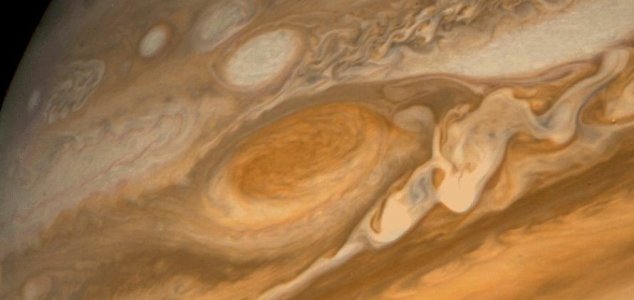Space & Astronomy
May 17, 2014 · 17 comments
17 comments

A close-up of Jupiter's Great Red Spot. Image Credit: NASA
This could soon be set to change however as this seemingly permanent feature of Jupiter's swirling atmosphere now appears to be getting smaller at a rate much faster than ever before. The latest calculations based on measurements from Hubble suggest that the spot is now shrinking at a rate of 580 miles per year.
"In our new observations it is apparent that very small eddies are feeding into the storm," said NASA's Amy Simon. "We hypothesized that these may be responsible for the accelerated change by altering the internal dynamics and energy of the Great Red Spot."
At the current rate of reduction scientists believe that Jupiter's trademark storm could disappear altogether within as little as 17 years.
Source: CBS News | Comments (17)
Jupiter's Great Red Spot is rapidly shrinking
By T.K. RandallMay 17, 2014 ·
 17 comments
17 comments
A close-up of Jupiter's Great Red Spot. Image Credit: NASA
Astronomers believe that the famous storm in Jupiter's atmosphere is reducing in size faster than ever.
First observed through telescopes as far back as the 17th century, the Great Red Spot is a massive Earth-sized anticyclonic storm that has both baffled and intrigued scientists for years.This could soon be set to change however as this seemingly permanent feature of Jupiter's swirling atmosphere now appears to be getting smaller at a rate much faster than ever before. The latest calculations based on measurements from Hubble suggest that the spot is now shrinking at a rate of 580 miles per year.
At the current rate of reduction scientists believe that Jupiter's trademark storm could disappear altogether within as little as 17 years.
Source: CBS News | Comments (17)

The Unexplained Mysteries
Book of Weird News
AVAILABLE NOW
Take a walk on the weird side with this compilation of some of the weirdest stories ever to grace the pages of a newspaper.
Click here to learn more

Support us on Patreon
BONUS CONTENTFor less than the cost of a cup of coffee, you can gain access to a wide range of exclusive perks including our popular 'Lost Ghost Stories' series.
Click here to learn more
Israel, Palestine and the Middle-East
UK and Europe
Ghosts, Hauntings and The Paranormal
Science and Technology
Total Posts: 7,606,841 Topics: 316,401 Members: 201,845
Not a member yet ? Click here to join - registration is free and only takes a moment!
Not a member yet ? Click here to join - registration is free and only takes a moment!




























Please Login or Register to post a comment.